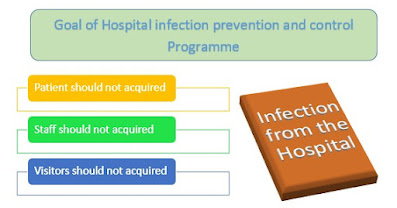Hospital Infection prevention and control Program
Hospital Infection prevention and control Program is simply means to manage and to control infections that may occur in the hospitals and which are known as healthcare associated infections (HAI) in patients, staff and visitors.
What is Healthcare Associated infections?
An Infection acquired by a patient in hospital/healthcare facilities in whom the infection was not present or incubating at the time of admission (usually after 48 hours).
This include infection acquired in hospital but appearing after discharge and occupational infections acquired by the staff of facility and by visitor.
However, a large percentage of HAIs are preventable through effective Infection Prevention and Control (IPC) measures. Infection prevention and control is also important to prevent the occurrence and spread of infections, thereby reducing the need for antibiotics.
Figure 1 Goal of Hospital prevention and control
To identify and reduce the risk of acquiring and transmitting infection among the patients, staff and visitors.
It is manage by the infection control organization, which include a multidisciplinary control committee (Hospital infection control committee) and Infection control team under the supervision of and with support of management.
Infection Prevention and control is extremely important because:
- Patient safety
- Accreditation
- Image of Hospital
- Insurance
- Bottom line of hospital to avoid litigation
- Staff health
- In addition, we have lot of Antibiotics resistance super bugs in environment which lead to HAIs like:
- MRSA (Methicillin-resistant Staphylococcus aureus)
- CRE (Carbapenem-resistant Enterobacteriaceae)
- VRE (Vancomycin-resistant enterococcus)
- MDR Pseudomonas.
- It also influences patient care in speciality like, critical care, internal medicine, gastroenterology, Surgery, Paediatrics, ENT etc.
- In addition, it also effect all device usage and surgeries and lead to HAIs related to central line, Catheter, Ventilator and Surgery
Why the healthcare associated infection (HAI) do occurs?
If we understand the chain of infections, it will help us to know the reason of Healthcare associated infections. To avoid HAI we need to break chain of infection.
1. Infectious agent
a. Patient
b. staff
c. Visitor
d. Environment
Which carrying the bacteria or virus on it
2. Reservoirs
Any person, animal, plant, soil or substance in which an infectious agent normally lives and multiplies. Reservoirs include humans, animals, and the environment. The reservoir may or may not be the source from which an agent is transferred to a host.
3. Portal of exit
Portal of exit is the path by which a pathogen leaves its host. Usually it is hands of healthcare workers, which touches one area and then transmitted to the other susceptible host, which could be any other patient or staff.
4. Portal of entry
a. Catheter
b. Ventilator
c. Surgery
d. Central line
5. Means of Transmission are the tracks through which infectious agents transmitted from natural reservoir to susceptible host and lead to infection. It can be direct or indirect mode of transmission.
A Direct Mode of transmission
· Direct contact
· Droplet spread
B Indirect Mode of transmission
· Airborne (dust and droplet nuclei)
· Vehicle (food, water and blood)
· Vector (mosquitoes, flies)
6 Susceptible Host
a. Susceptible host are those who is most likely to expose next to pathogens.
b. Susceptibility of host depend on genetic, immunity and non-specific factor of and individual to resist the ability of infection.
c. Examples of susceptible host
i. Children who are very young
ii. People who are very old
iii. People on inadequate diets
iv. People who are chronically ill
v People receiving medical therapy such as chemotherapy or high doses of steroids
vi. People who are already ill
vii. People with open wounds
To beak chain of infection, we need to have Infection prevention control plan and plan should be SMART.
S Surveillance
M Monitoring and Auditing
A Antibiotic policy
R Reporting and isolation of disease
T training of staff
Figure 6 Infection Prevention and Control PLANInfection Prevention and Control PLAN









Post a Comment